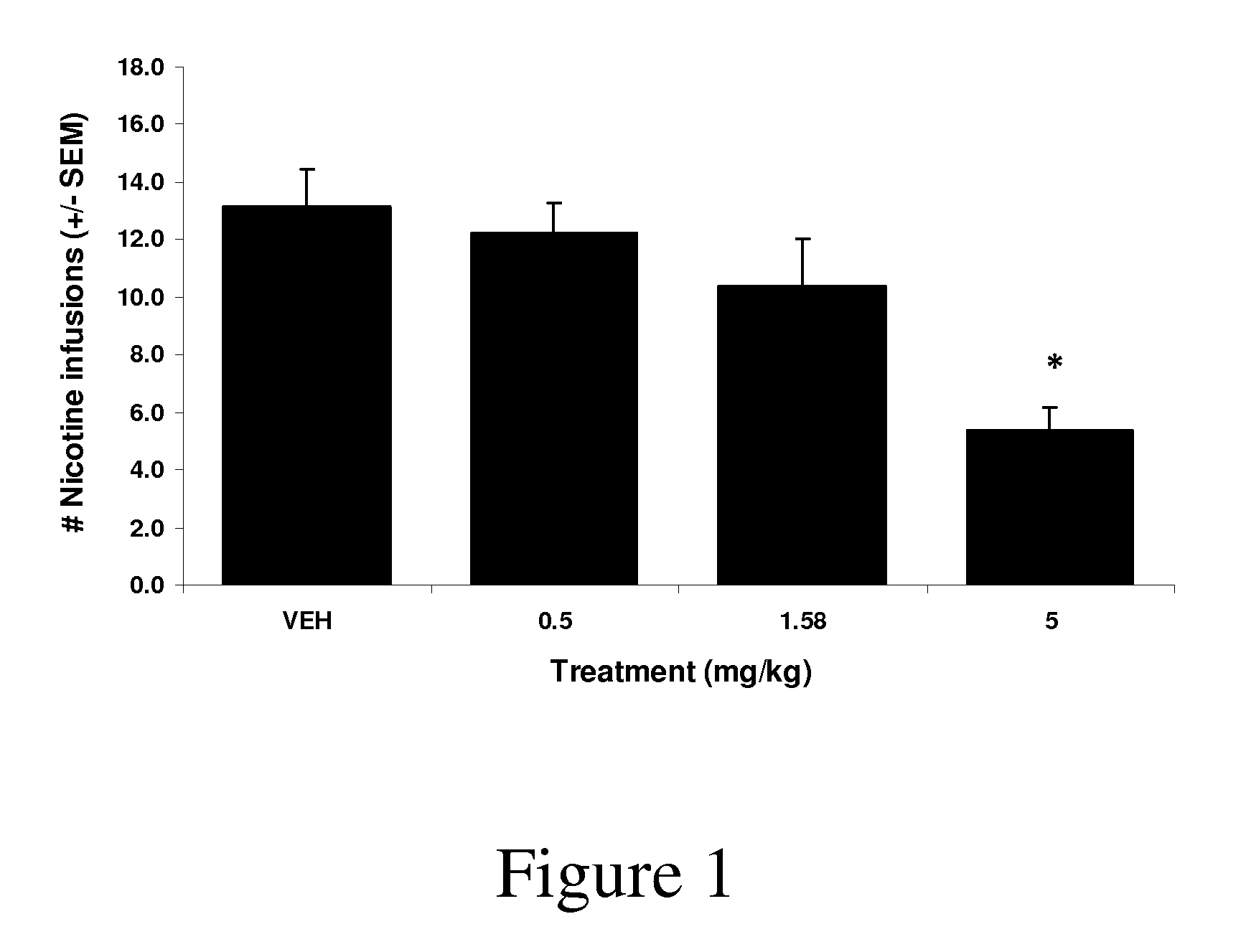Synthetic compounds and methods to decrease nicotine self-administration
- Summary
- Abstract
- Description
- Claims
- Application Information
AI Technical Summary
Benefits of technology
Problems solved by technology
Method used
Image
Examples
example 1
Chemical Synthesis of Nicotine Analogs
[0134]General procedure for the synthesis of 1-alky and 1-benzylimidazoles. Into a 20 mL vial was placed the alkyl or benzyl halide (1.0 equiv.) and imidazole (3.0 equiv.). The neat mixture was heated to 90° C. for 3 h with stifling at which time the reactants melted. After three hours the reaction was cooled to room temperature and the resulting residue was partitioned between 5 M NaOH and CH2Cl2 (10 mL each). The organic portion was removed and concentrated in vacuo. The target compounds were fully characterized spectrally and subjected to biological evaluation. Purity was determined to be >95% by HPLC analysis of the compounds.
[0135]N-(4-Chlorobenzyl)imidazole (Compound 3). The title compound was purified by silica gel chromatography using 10% MeOH in CH2Cl2 (53% yield). 1H NMR (300 MHz, CDCl3) δ 4.9 (s, 2H), 6.72 (s, 1H), 6.89 (m, 3H), 7.11 (m, 2H), 7.36 (s, 1H); 13C NMR (75.43 MHz, CDCl3) δ 50.06, 119.03, 128.41, 129.02, 129.91, 134.21, 137...
example 2
Nicotine Analogs as Inhibitors of CYP2A6 Mediated Coumarin 7-Hydroxylation
[0140]The inhibition of human CYP2A6-mediated 7-hydroxy coumarin formation was evaluated in the presence of select test compounds in a standard assay (Greenlee et al., J Pharmacol Exp Ther, 1978). Our first studies were with highly purified human CYP2A6 that provided a convenient and relatively high-throughput measure of CYP2A6 inhibition. Full dose-response IC50 values (nine concentrations) were determined (Table 1).
TABLE 1Inhibition of human CYP2A6 and rat CYP2B6 in the presence of substituted heteroaromatic compounds and physicochemical properties of compounds 1-11.rCYP2B1rCYP2B1hCYP2A6hCYP2B6% % CompdIC50 (μM)IC50 (μM)inhibitionainhibitionbtPSAcCLogPd10.666.4 NDe53.862.8020.867.4ND55.359.9−0.230.1612ND35.515.62.540.1652.2ND42.738.41.450.23.9ND47.912.42.660.2191ND46.647.60.97>200NDND43.327.90.38800103NANA36.70.79NAfNAND53.527.90.61017011ND56.915.62.611618>20ND67.715.62.1aInhibitor present at 25 μM;bInhibito...
example 3
CYP Inhibition Assay
[0141]To gain insight into the selectivity of the synthetic compounds for inhibition of other CYPs, we examined the major CYPs present in human liver. Prior to these studies we showed that the nicotine analogs were quite metabolically stable in the presence of mouse or rat or human liver microsomes (i.e., T1 / 2>60 mins). That the nicotine analogs showed low or no inhibitory activity against other CYPs suggests that the inhibitors examined selectively inhibited CYP2A6. A typical incubation mixture (final volume 0.25 mL) contained 50 mM Tris or KPhos buffer (pH 7.5), 0.5 mM NADP+, 2.0 mM G6P, 1 U of G6P dehydrogenase and 0.6 mg DETAPAC and the inhibitor was added last to minimize interaction with the protein. After mixing on ice, the reaction was initiated by the addition of substrate and incubated at 37° C. with shaking in air. Organic extracts were analyzed by fluorescence (for fluorometric substrates) or injected onto a Hitachi L-7100 system equipped with a Hitac...
PUM
| Property | Measurement | Unit |
|---|---|---|
| Digital information | aaaaa | aaaaa |
| Fraction | aaaaa | aaaaa |
| Fraction | aaaaa | aaaaa |
Abstract
Description
Claims
Application Information
 Login to View More
Login to View More - R&D
- Intellectual Property
- Life Sciences
- Materials
- Tech Scout
- Unparalleled Data Quality
- Higher Quality Content
- 60% Fewer Hallucinations
Browse by: Latest US Patents, China's latest patents, Technical Efficacy Thesaurus, Application Domain, Technology Topic, Popular Technical Reports.
© 2025 PatSnap. All rights reserved.Legal|Privacy policy|Modern Slavery Act Transparency Statement|Sitemap|About US| Contact US: help@patsnap.com



